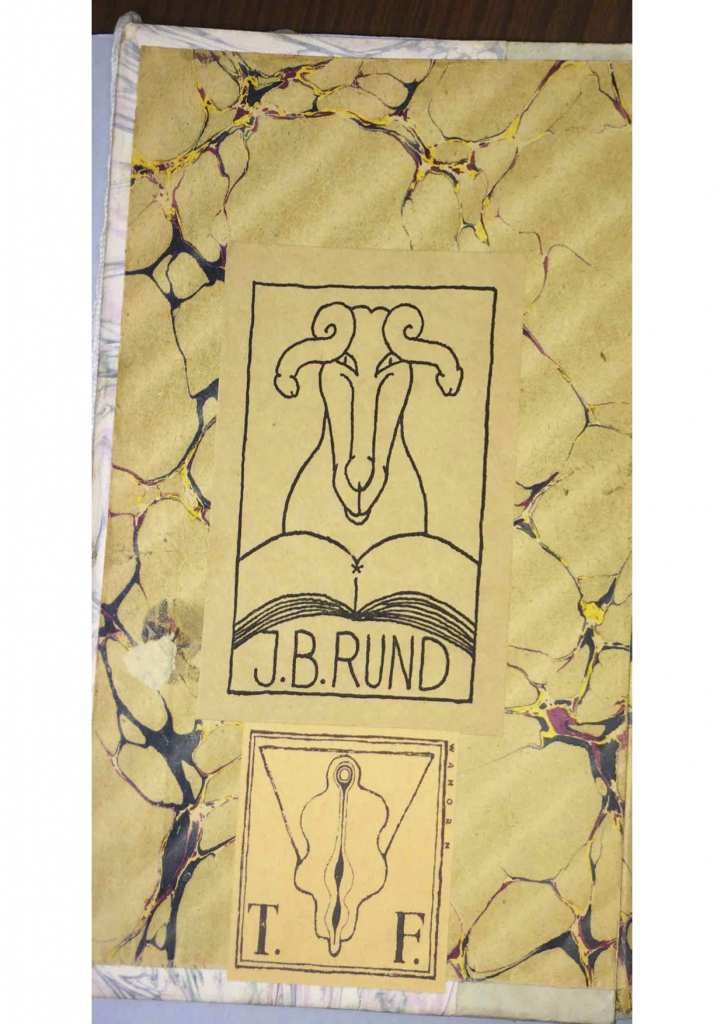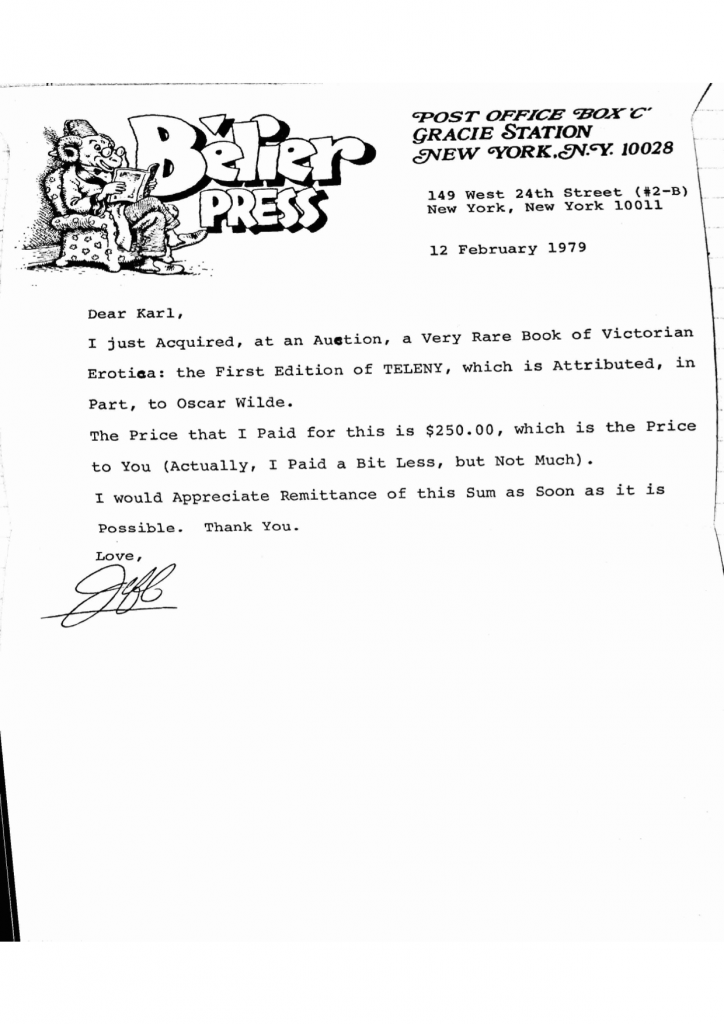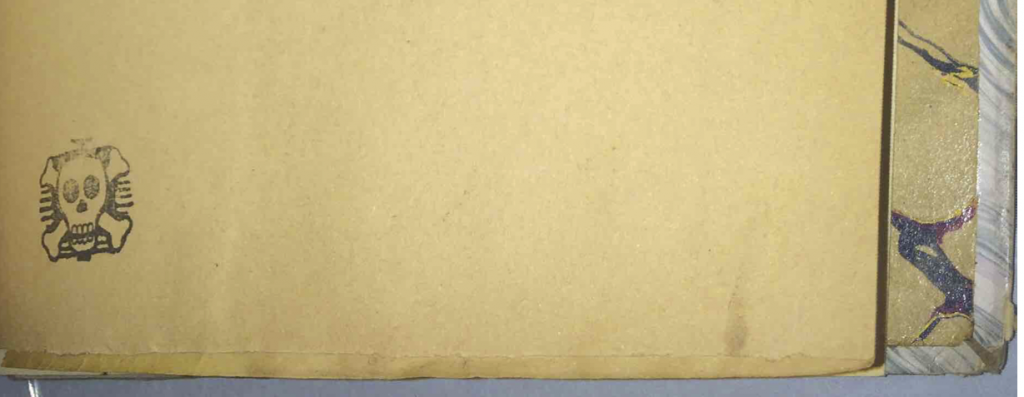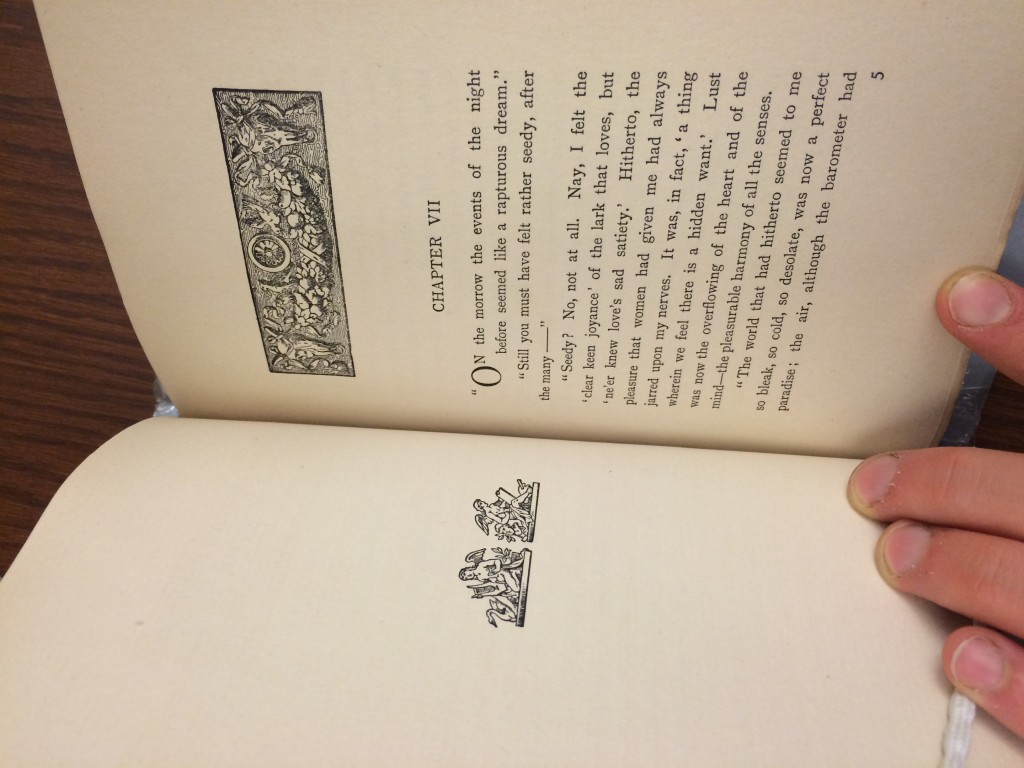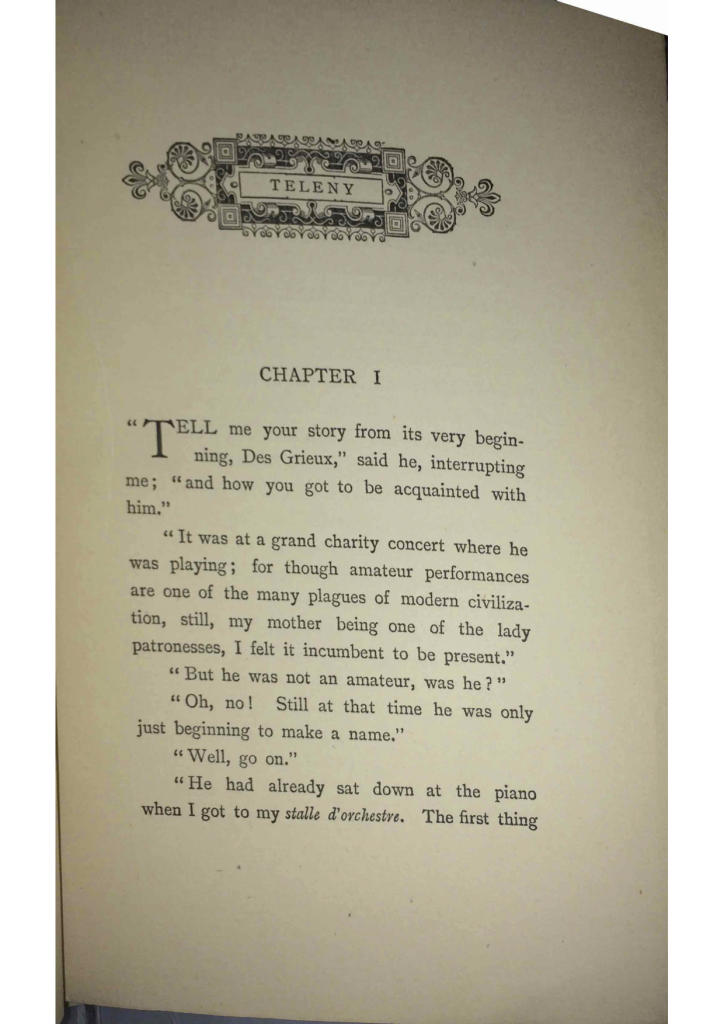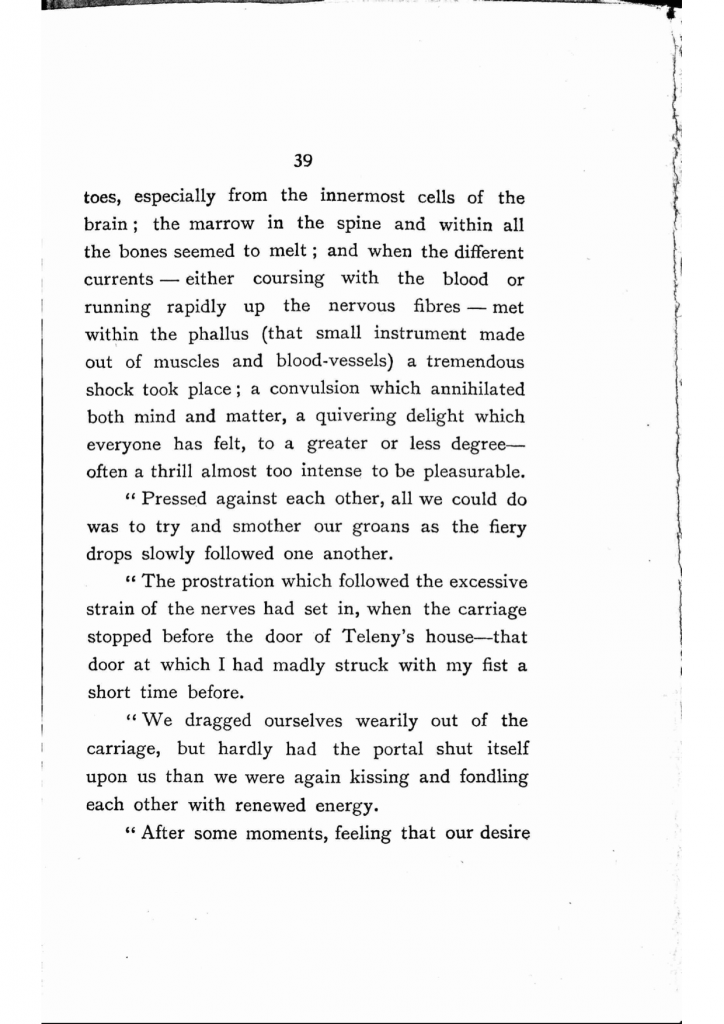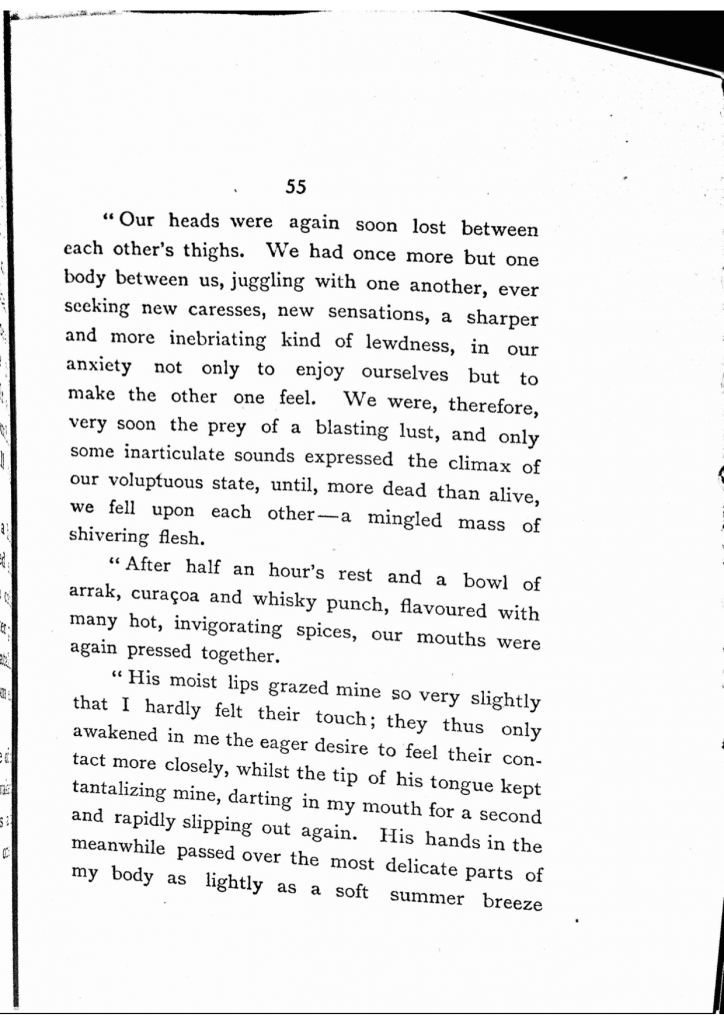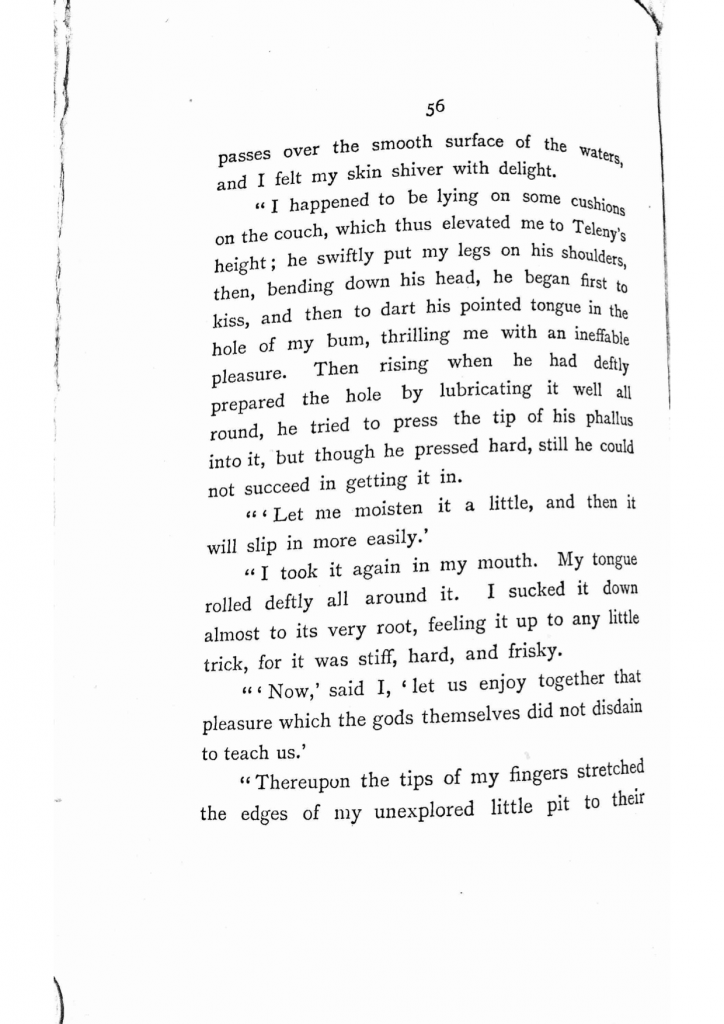General
Teleny, or the Reverse of the Medal is a homoerotic Victorian novel published anonymously in two volumes in London by Leonard Smithers, H.S. Nicholson, and/or Edward Avary in 1893. The first run of Teleny was small and privately issued; only 200 copies were printed and distributed, with the imprint “Cosmopoli” on the cover page. Much mystery and fame surround the text as it is believed to be written by or in part by Oscar Wilde, although this is still largely contested. UBC Rare Books and Special Collections acquired Teleny as well as its prequel Des Grieux (Of Which only 2 known copies exist) through auction in early 2015 with the aid of a Kickstarter campaign started by Victorian Literature PhD candidate Justin O’Hearn in November 2014. The RBSC currently holds the only known collection with both original texts.
Plot
Teleny, or the Reverse of the Medal is narrated by Des Grieux, who in the opening of the novel becomes transfixed by a piano performance of the alluring and virile Teleny, and a subsequent relationship of sexual telepathy. Confused by his feelings for Teleny, Des Grieux experiences immense jealousy and internalized homophobia while he witnesses Teleny’s many sexual exploits with various men and women. Convinced his homosexual desires are immoral, Des Grieux attempts to force himself to love a household servant girl, consequently raping her, thus, causing her to commit suicide. Des Grieux eventually confesses his love for Teleny and the two rapidly become entwined in a heated and overtly passionate sexual relationship weighted with blackmail and manipulation. The two split for a short time, but Des Grieux discovers Teleny in bed with Des Grieux’s mother, who has agreed to relieve Teleny of his monetary debt in exchange for sex. Des Grieux attempts suicide, and after leaving the hospital goes immediately to find Teleny, who has stabbed himself in despair for having deceived Des Grieux. As Teleny lay bleeding to death, they once again confess their love for each other, express forgiveness, and Teleny perishes.
The Book as Object
The edition of Teleny, or the Reverse of the Medal that is housed in the UBC Rare Books and Special Collections library is copy 160/200. The book itself is bound with paper marbling and the edges of the paper are cut without uniformity, meaning they are staggered in length and give texture to the edges of the book. Some pages are actually shorter than others, suggesting the books were put together rather haphazardly, which might be a product of their extremely graphic and sexual content, as well as the economic restriction of financing a privately issued run of publishing.
Inside the book cover there are two bookplates which are decorative labels, often depicting a coat of arms or an insignia to denote the provenance of the book, or a previous owner. In the case of Teleny, the first bookplate depicts a Ram reading an open-faced book. The ram’s horns are two phalli pointed downwards with the name J.B. Rund inscribed below the book. The second bookplate depicts a vulva ensconced in an upside down triangle with the initials T. F. on either side at the bottom of the plate. In addition, the name “Wanhorn” is written down the right side of the border of the plate.
There is no information I could find on who T. F. Wanhorn could be. However, J. B. Rund is the name of a publisher and editor at Belier Press which publishes erotic comics and zines. Tucked in between the last page of the book and the back cover is the letterhead of Belier Press in a letter which follows below:
While it is impossible to know who Karl is, Jeff is actually Jeff B. Rund. It is unknown whether or not Jeff succeeded in passing on the book to Karl. Because his bookplate remains in both Teleny and Des Grieux it is possible he held on to both copies after assessing their worth, or he may have just added his bookplate to the texts to track their provenance. The plot thickens, and the mystery deepens.
In addition to the bookplates, there is also a stamp of a skull at the back of both Teleny and Des Grieux. The significance of this is unknown. More mystery.
In addition to the bookplates and stamp, there are also a number of ornamentations in Teleny that mark the ends of chapters or accompany the beginning of a chapter. One such ornamentation is pictured below. Due to the small run of the text it is much more likely that these ornamentations are Electrotype, also called galvanoplasty, rather than Woodblock Engravings, as electrotype was being used more frequently towards the mid-to-late Nineteenth Century. In fact, “In the second half of the century, most woodblock engravings were actually printed from electrotypes of one kind or the other.”
Authorship
While the story of Teleny’s authorship as linked to Oscar Wilde can be found in many biographies of the flamboyant and extravagant author, the account is exclusively told by Charles Hirsch, the owner of a French literature bookshop that had a sideline in erotica, called Librairie Parisienne. It is summed up nicely in “‘An Uninterrupted Current:’ Homoeroticism and Collaborative Authorship in Teleny” by Robert Gray and Christopher Keep, but basically Hirsch claims that in 1890 Wilde would visit his shop, leaving a wrapped up package and would instruct Hirsch that another man would pick the package up later. This would purportedly happen several times with several men operating as authors in a chain-authorship fashion with the Librairie Parisienne as the hub of pornographic exchange.
The attribution of Teleny to Wilde certainly lends the book a larger fame than it would have without; however, according to Dr. Gregory Mackie, professor of Victorian Literature at UBC, the anonymous nature of the text doesn’t fit with Wilde’s notorious obsession with fame and notoriety. Robert Gray and Christopher Keep state that the purported collective authorship may have been an attempt to get around leaving any one author vulnerable to prosecution for authoring homosexual pornography. They state, “It is against the backdrop of this enormous effort to fix the enigma of the sexual invert, this manifest need to force the homosexual to speak the secrets of his ‘true’ sexuality, that one should read the communal authorship of a queer text such as Teleny. In its various tracings of ‘the uninterrupted current’ that forms its governing conceit, one hears not so much the articulation of a genuine or authentic ‘queer voice’ as one senses the physical effort on the part of its ‘various hands’ to resist any such violent acts of naming.”
Publishing
Leonard Smithers is at least one of several publishers of the illicit text of Teleny. The others being H.S. Nicholson, and/or Edward Avary. Smithers’ involvement with the publishing of Teleny is inextricably linked to Wilde, as he has previously worked with Wilde, was one of the only publishers to publish Wilde after his Trials for homosexual conduct in 1895, and was closely associated with the Decadent Movement of the Nineteenth Century.
Smithers’ publication of Teleny, or, The Reverse of the Medal omitted the prologue from the manuscript, included a subtitle “A Psychological Romance of To-day” to the title, and also changed the setting of the novel from London to Paris. James G. Nelson quotes John Mcrae’s introduction to Teleny in “Leonard Smithers’ Role as Publisher of Teleny” stating, “transferring of the action of Teleny to Paris, while in no way lessening the risqué content of the book, gave an added fashionable frisson of Frenchness to an already highly esoteric work. The fascination of the Aesthetic movement, for things French–from yellow-bound books to the eroticism of Pierre Louys makes Smithers’ alteration both understandable and apposite.”
Acquisition of Teleny, or, The Reverse of the Medal
PhD Candidate Justin O’Hearn started a Kickstarter campaign in November of 2014 when Teleny, or, The Reverse of the Medal and Des Grieux were set to go up for auction at Christie’s. Effectively raising more than $3000 from backers of the campaign, the Rare Books and Special Collections library at UBC provided the rest of the funding. Teleny was purchased for $16,000 while Des Grieux was purchased for $23,000, an understandable mark-up since J.B. Rand’s purchase of Teleny in 1979.
O’Hearn is working on producing the second ever edition of Des Grieux, an immensely important work for Homoerotic literature as distribution of the text is restricted to the only two known copies of the book.
Takeaways
Overall, I found the research of this text to be quite illuminating on the obsession around attribution of work to an artist. Regardless of who the author(s) of Teleny and Des Grieux are, the works are invaluable as artifacts of early Homoerotic literature. When I first decided to research these texts, I thought, “Banned Victorian homosexual pornography? So, what, they say penis and two men kiss?” Boy, was I wrong. These texts are as explicit and graphic as possible, with such gems as the passages below (WARNING* NSFW…Seriously). What astounds me, and honestly filled me with a strange sense of satisfaction, is how much love is displayed between Teleny and Des Grieux. While their relationship is largely sexual, there is an immense aspect of spirituality and deep love between the two men, which I think is something that is still overlooked in media portrayals of same-sex relationships today in the 21st Century.
If you want to look at Teleny or Des Grieux, which you should, you can find the call numbers at the RBSC here!
